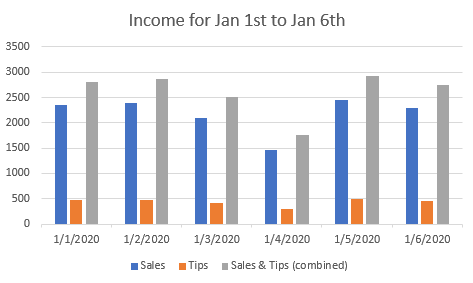Some words are used so frequently that they can get exhausting to type or write over and over.
Sometimes, English and many other languages adopt common shorthand signs or symbols as a result.
Let’s take a look at one of the most popular English symbols, the and sign or ampersand (&).
[toc]

Is it grammatically correct to use the “and sign”?
The and sign, or ampersand, is a form of shorthand and shouldn’t be used when writing a formal document like a school assignment, an official letter or email or any kind of report.
However, there are places when it is acceptable to use an ampersand. If you have a chart or table, the and sign can save space when labeling an axis or column.
Ampersands should also be used if they are an official part of a company name or other kind of name, or if they are part of an abbreviation.
What is an ampersand?
The ampersand is also known more commonly as the “and sign.” It looks like this: &
Grammatically speaking, the ampersand and literally spelling out the word “and” are identical. There’s no special meaning which applies when you use an & instead of the word “and,” in other words.
However, just like the @ (at sign), the ampersand is a kind of shorthand for a real word. That means it isn’t really appropriate to use in more formal written registers, such as when turning in a school assignment, delivering a report for an organization or writing any other kind of official letter, email or communication.
But where does the ampersand come from, why do we even have it and what exactly are the rules for using it in writing?
Let’s find out!
The Roman origins of the and sign
The first documented use of the and sign is in early classical Latin, where it originally represented the letters “e” and “t” joined together.
Why?
Because “et” is the Latin word for “and.”
As time went on, and especially in more ornate, cursive styles of Latin, the two letters came to be joined together so regularly, and so often referred to this specific word “and,” that an entirely new symbol was created: the &.
Historically, Latin was the universal language of the educated, so even when the Romans were long gone the and sign stuck around, finding its way into various important writings over the centuries.
At some point, it became essentially its own letter of the English alphabet, which leads us to our next point of interest on this tour of the ampersand.
Why the and sign is called an ampersand
Let’s be honest: the word “ampersand” is pretty strange.
Based on the explanation above, you might think it comes from Latin. In fact, it kind of does, but not in the way you might think.
The Merriam-Webster blog breaks down the etymology of this unusual word.
As noted above, the and sign actually used to be part of the English alphabet. When students learned to recite the alphabet, they would put the word “and” at the end, after Z.
To do that, they wouldn’t just say, “… X, Y, Z and.”
Instead, they would use the Latin phrase “per se,” meaning “by itself,” to separate the and sign from the rest.
That sounded like this: “… X, Y, Z and per se and.”
By the late 1800s, according to Oxford dictionaries, the word “ampersand” was in regular use as a way of referring to the and sign.
Ampersand grammar rules
Now that we’ve got our digression into the interesting history of “ampersand” out of the way, let’s explore the grammatical rules for using the & in writing.
Technically speaking, the word “and” and the symbol & are grammatically identical.
Even though that’s the case, there are definitely times when it’s inappropriate to use an & instead of writing out “and.”
Read on for all the rules and regulations you’ll ever need to know.
When not to use an and sign
Put simply, you should never use an and sign unless there’s a specific reason to do so.
That means if you’re just writing a sentence and need to connect two phrases, words or clauses with “and,” you should just write the word out.
This is especially true in formal writing, whether that’s a school assignment or any kind of official report for a business or other organization.
Even in emails, which can be casual, the use of an & instead of the word “and” can be jarring.
In the worst case scenario, it might give the person you’re writing to the impression that you just don’t care that much about something.
To stay on the safe side, always use the written word “and” in formal writing.
Of course, there are some exceptions to the rule, which are described below.
Using the and sign in charts and tables
If your document includes a chart, table or other kind of figure, the and sign can often be a way to make your columns and labels more legible so that readers can focus on the data you’re presenting.
In any chart or table, simply replace the word “and” with an & sign any time you need one.
Treat the & like any other word, placing a single space on either side of it.
Examples

In this fairly simple example of a chart, the & in “sales & tips (combined)” means the same thing as “and.”
However, because there is already a lot going on in a typical chart, the use of the “and” sign serves to reduce the amount of reading someone has to do to understand the chart’s data, which is more important.
Chart labels also don’t usually have a lot of space to occupy, so it’s important to save space whenever you can.
Using the and sign as part of an acronym
Another common use of the and sign in writing is when it forms part of an acronym.
For instance, “research and development” can take up a lot of space, especially if it needs to be written out multiple times.
Instead, it’s quicker and more readable to abbreviate the phrase to its first letters, “r” and “d.” You can’t use the word “and” to connect these letters, because people might wonder if “RandD” is supposed to be a word.
This is a situation where the and sign really shines. Writing out R&D is immediately clear to the reader, and saves space as well.
Speaking of spaces, unlike most uses of the and sign, acronyms don’t need a space on either side of the sign.
Simply write the first part of the acronym, insert an & immediately after and then follow the & with the last part of the acronym.
Of course, if the acronym you are using is not familiar to the average reader, it’s a good idea to spell the words out the first time you use it in a document and include the acronym afterward in parentheses.
That is, you might write that your “research and development (R&D) team” is working on a new invention, and thereafter simply use the acronym R&D.
Examples
Because these are routinely used, there’s no need to spell out what they mean.
Using the and sign in a company or other name
Some companies use an and sign as an official part of their name. The same can also be true for other groups or entities.
In fact, even some musical genres and other standard phrases use an & instead of the word “and.”
If you are writing about a company or other group whose name officially includes the and sign, you should spell it with the & even in an official or formal document.
For musical genres and other stock phrases that commonly have an & in them, it’s best to follow the rules of formal writing and spell out the word “and,” unless there’s some compelling reason not to.
Examples
In the first example here, the phrase “rhythm & blues” is often written out with an ampersand.
In this case, the writer has chosen to use the word “and” instead, perhaps because this is a formal explanation of a record label.
However, there might be times when it’s more appropriate to still use the & with this sentence.
For instance, if the order of the genres is flipped so that “rhythm and blues” is at the end, it might be difficult to tell whether “blues” its supposed to be its own genre or part of “rhythm and blues.” (That ambiguity also makes this sentence a good place to use a serial comma!)
To avoid confusion, in that case the sentence might look like this:
“The record label’s artists sing in many genres, including rock, gospel and rhythm & blues.”
It’s incredibly clear now that “rhythm & blues” is a single genre, rather than two separate ones.
Using the and sign in a list
When you use the and sign in a list, you should follow the regular rules for using “and” in a list.
That is, if your style guide or ambiguous context requires a comma for clarity, you still should add one even if you’re using an & instead of the word “and.”
If you aren’t sure if your style guide uses a comma in this case, it’s usually safe to leave it out unless the meaning is unclear (like in our previous example).
Of course, there isn’t really a good reason to use an & instead of an “and” in a written list in most cases, so this shouldn’t come up very often anyway.
How to type the and sign
Now that we’ve discussed how to use the and sign, what about how to type one?
This will depend on whether you are using Windows or MacOS, and of course on various mobile devices the instructions might differ a bit.
International keyboards also differ. For the sake of clarity, the instructions below all refer to standard American keyboard layouts. (If you’re a Dvorak keyboard enthusiast, you probably already know how to do this, but the number keys and symbols are in the same place anyway.)
Typing & on a Mac
If you have MacOS on a desktop computer or laptop, and are using a connected keyboard, you will see the & sign above the number 7 toward the top of the keyboard.
To type an & instead of a 7, hold down the “option” key and press the “7” key to write “&” instead.
Typing & on Windows
Windows keyboards also place the & sign above the number “7” toward the top of the keyboard.
On Windows, you need to hold down the “shift” key and then press “7” to type an “&.”
Typing & on tablet or smartphone
The exact instructions for typing an & on a tablet or smartphone will depend on your operating system and the software keyboard you are using.
Android
On the standard Android keyboard (Gboard), the & is located behind the “?123” button to the left of the space bar.
iPhone
On a standard iPhone keyboard, the & is behind the “123” key, located to the left of the space bar.

Hey fellow Linguaholics! It’s me, Marcel. I am the proud owner of linguaholic.com. Languages have always been my passion and I have studied Linguistics, Computational Linguistics and Sinology at the University of Zurich. It is my utmost pleasure to share with all of you guys what I know about languages and linguistics in general.

